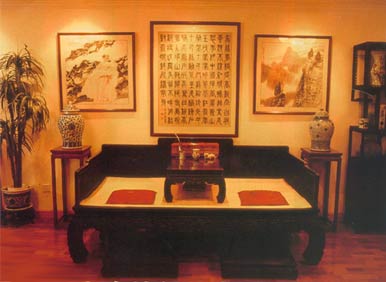|
| |
Originally,
"Qinggong" means the elegant offerings.
Being called it with an elegant name because
most of the literati cherish study appliance.
Water bowl is the fifth treasure in addition
to writing brush, ink stick, ink slab and
paper, and ancient Chinese scholars put them
on desks for practical use as well as artistic
appreciation. Water bowl is actually a kind
of water vessel containing water for use of
making fluid ink from ink stick, and it was
a necessary tool in Chinese studying rooms.
|
|
 |
"Lvyuantang
Antique Shop" neighboring water, located
in Jinxi Town in Jiangsu Province, is a three-floored
traditional Chinese building. The water bowl
museum located in the third floor should be
highly praised. According to years, the water
bowls are made by different craftsmen from
the Qin dynasty, the Northern Wei State, the
Western Jin Dynasty, the Tang dynasty, the
Song dynasty, the Yuan dynasty, the Ming dynasty,
the Qing dynasty and so on. According to the
material, the water bowl are divided into
copper, iron, porcelain, jade, ivory, carnelian,
crystal, the root of bamboo, peculiar stone
and so on. Among them, a black ceramic water
bowl inside which caves posy and coarse flower
design especially catch people's eyes. Watching
from the appearance, it is like a "Jue"
glass. The water bowl made before 2200 years
|
has already possessed high artistic level because
ceramic industry sprang up not very long and there
was not the conception about "study appliance".
| With the development
of the society, the manufacturing of water
bowl has also been improved gradually in terms
of both modeling and technique. For examples,
there is a water bowl in the shape of tymbal
made at the years of Western Jin dynasty in
the revelation cabinet. Its wave design is
carved elaborately as if you hear the sound
of the great waves. Another one is a water
bowl in the shape of fish (porcelain body)
made at the period of the northern Wei State.
Its appearance is like the wooden fish used
in the temples. It embodies a kind of moving
feeling although its body is empty. Both of
them are rare masterwork. In addition, there
is still a "sancai" water bowl made
at the Tang dynasty.It has not |
|
only unique modeling but also elegant color of glaze.
The elaborate products are seldom seen indeed. The
modeling of water bowl is constantly innovated after
the Tang dynasty. For instances, both the water
bowl in the shape of kettle made at the Ming dynasty
and the ones in the shape of arhat are unique in
style. The former one is surrounded by some small
vases which can be used to fill with flowers. An
arhat statue is put in the later one. There is still
another water bowl in the shape of hoptoad at the
shop. It has a moral that people who use it will
succeed in a government examination. The manufacturing
of water bowl has reached a prime down to the Qing
dynasty. The ceramic craftsmen nearby Wuxi and Jiangsu
adopted furnace transmutation technology to fire
porcelain at that time. Both the tea powder water
bowl and the water bowl in the shape of chun red
glaze dog made at years of Kangxi belong to furnace
transmutation products. The modelling of the former
one is elegant and the color of the glaze is smooth
and tender. The furnace transmutation part of the
later one is only the leg part of dog. It is wonderful
artical excelling nature. In addition, the modeling
of the eel back water bowl made at the years of
Qianlong, the redware cowboy water bowl made at
the years of Jiaqing and the bamboo root carving
water bowl are all truth to life. There is still
a pair of jewelry glaze and tiger skin glazed water
bowl which can be called treasure in the shop. Both
of them are from Ge Mingxiang and Ge Yuanxiang living
at the years of Qianlong. Both of them were famous
ceramists at that time. The ceramic body made by
them is not only dense but also glazed by deep black
or deep blue glaze. The luster becomes uneven after
furnace transmutation. It becomes strong from the
top to the bottom gradually. Because their way is
similar to Ou Ziming, a famous ceramist in the Ming
dynasty, their works often take on the color among
grey, black, blue, green and so on.
Wondering around the private museum, I could learn
the complete history of water bowl manufacturing.
If you face a world of different water bowls, will
you try to think about the lifestyle of ancient
intellectuals and their tastes?
|
| |
|
|
|
|



